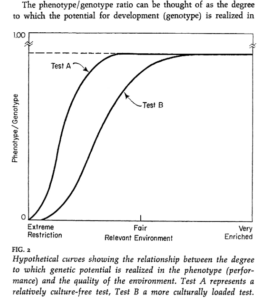This term deserves more widespread use, since the fallacy is still so common, more than 50 years after it was given a name. I have traced the naming of it back to 1969, in an obscure reply from Jensen to a critic:
- Jensen, A. R. (1969). Counter Response. Journal of Social Issues, 25, 219-222.
- (you can find the critic Jensen is replying to here, but the chronology is a little weird because she is apparently replying twice to something published elsewhere before Jensen gets a say)
I quote the relevant parts:
The Tulkin article referred to by Dr. Alfert is one of the 43 published studies of Negro-white IQ differences which attempted to control for socioeconomic status (SES) and/or other environmental factors. In all but three of these studies, the white mean was higher than the Negro within SES groups; the remaining mean difference, over all studies, with SES “controlled,” was 11 IQ points (Shuey, 1966). Tulkin statistically “controlled” both for SES and a number of more subtle family variables. He concluded: “When family differences were also statistically con- trolled, there were no significant racial differences on test scores in the upper socioeconomic group, although differences remained significant in the lower socioeconomic group. ”
But the statistical matching of racial groups on SES and other environmental factors is an invalid method in any of these studies, since it presumes that SES, etc., are entirely causal variables. Since there is substantial evidence that there are genetic as well as environmental differences between SES groups (within races), a matching procedure (statistical or actual) results in some degree of matching on the genetic as well as the environmental factors involved in mental development. Thus the independent and dependent variables in these experiments are hopelessly confounded. Paul Meehl has written cogently on this “sociologists’ fallacy”:
While every sophomore learns that a statistical correlation does not inform us as to the nature of the causality at work (although, except for sampling errors, it does presumably show some kind of causal relation latent to the covariation observed), there has arisen a widespread misconception that we can somehow, in advance, sort nuisance-variables into a class which occurs only at the input side. This is, of course, almost never the case. The usual tendency, found widely among sociologists and quite frequently among psychologists (particularly among those of strong environmentalist persuasion) is to assume sub silentio that there is a set of demographic-type variables, such as social class, domicile, education, and the like, that always operate as nuisance variables to obscure true relationships, and that function primarily as exclusively on the input side from the standpoint of causal analysis. This automatic assumption is often quite unjustified. Example: We study the relationship between some biological or social input variable, such as ethnic or religious background, upon a psychological output variable, such as IQ or achievement. We find that Protestants differ from Catholics or that Whites differ from Blacks. But we find further that the ethnic or religious groups differ in socio-economic class. We conclude, as an immediate inference and almost as a matter of course, that we have to ‘control’ for the socio-economic class variable, in order to find out what is the ‘true’ relationship between the ethnic or religious variable and the psychological output variable. But of course no such immediate inference is defensible, since on certain alternative hypotheses, such as a heavily genetic view of the determiners of social class, the result of such a ‘control’ is to bring about a spurious reduction of unknown magnitude in what is actually a valid difference (Meehl, 1970)
The works cited by Jensen are:
- MEEHL, P. E. Nuisance variables and the ex post facto design. In M. Radner & S. Winokur (Eds.), Minnesota Studies in philosophy of Science. Vol. 4. Minneapolis: University of Minnesota Press, 1970.
- SHUEY, AUDREY M. The testing of Negro intelligence (2nd ed.). New York: Social Science Press, 1966
